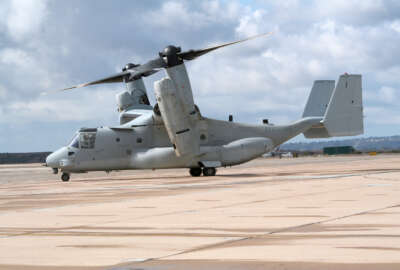Army aims for speed in new $10B software contract
Potential bidders have until the end of this week to offer comments on the Army's latest draft request for proposals. 15-20 firms will win spots on the contract...
The Army wants to create a huge new ID/IQ contract to modernize the way it buys and builds software — and it’s not wasting any time. Just a few months after the idea was first announced, the service has already issued a request for information and two draft requests for proposals.
It’s going to be a tight turnaround for potential bidders to submit their comments on the Army’s latest draft, issued on Oct. 11; the deadline is this Friday. After that, officials are planning one more draft RFP, and then an industry day on November 7 before the final version of the solicitation that vendors will bid on. That timeline is basically unheard of in the world of large federal ID/IQ contracts, which typically take the government years to plan and award.
Danielle Moyer, who leads the Army’s Digital Capabilities Contracting Center of Excellence at Aberdeen Proving Ground, said things really can move that quickly.
“I have zero patience. When I was just a contracting branch chief, we had the [Joint Tactical Radio System] programs, and we awarded a $16 billion contract from start to finish in four months,” she said Tuesday at the annual AUSA conference in Washington. “I don’t understand why things take 18 months. For this contract, [Principal Deputy Assistant Secretary for Acquisition, Logistics and Technology] Young Bang had the idea of a capacity contract on a Friday night. [Deputy Assistant Secretary for Data, Engineering and Software] Jennifer Swanson texted me five seconds later, and I said, ‘Well, let’s do it.’ We had an RFI a couple days later. I don’t understand why that’s not how the world works, but it should be that way.”
At the AUSA event, officials offered some more details on the current thinking about how the estimated $10 billion, 10-year contract will work, while also emphasizing it will continue to evolve between now and the final RFP based on contractors’ input, and that it won’t be the only vehicle the Army uses for software procurements.
As of now, officials estimate the new vehicle will initially include spots for 15 to 20 vendors, all of whom will compete for individual task orders. The Army has previously said the contract will include frequent on-and-off ramps to refresh that vendor pool, but for the first round, the Army will also pre-qualify vendors who don’t make the first cut, but still look like good candidates.
Swanson said that pool of “selectable-but-not-awarded” companies will be based, like the winning contract holders, on the results of a technical capabilities challenge the Army plans to design as part of the source selection process.
“There will be other companies that are acceptable on the tech challenge, but who don’t get the initial award,” she said. “We will choose from that pool of selectable-not-awarded as we on-ramp new companies, and that will largely depend on the performance of the companies that we initially select, and demand, which I think there will be a lot of.”
Swanson also clarified the scope of the contract: The Army doesn’t intend to use it for purely commercial-off-the-shelf software. The focus is on software development using agile methodologies.
“We are not going to use this contract to straight up buy commercial software — that doesn’t make sense. We can just get an [enterprise license agreement] for that, and that will always be firm fixed-price. We are not going to use cost-plus contracts for buying commercial software, because that would make no sense,” she said. “However, there are going to be efforts that are a combination. We may leverage commercial products and configure them. We may have commercial products as part of a solution where there is additional development that’s required. What we don’t want is to constrain this contract in any way that doesn’t support whatever the needs are over the next 10 years.”
Some of the other changes in the latest draft solicitation: The Army will open the contract up to vendors who’ve never worked for the government before. As part of that, vendors also won’t need facility security clearances. Vendors won’t have to be as specific as they normally would about the labor rates they’re proposing to charge the government. Details like that will be competed and decided at the task order level.
It’s a tricky balance deciding how many of those details to figure out in the base contract and how much to leave to task orders. After all, the whole point of an ID/IQ is to streamline those task order awards.
And Col. Matt Paul, the program manager for the Army’s Integrated Pay and Personnel System, said officials are trying hard not to make those task order competitions too burdensome.
“It’s going to be hard to get on that contract — on purpose. However, as one of the primary customers on that contract, my pledge is that we won’t make companies relive all of that pain over again at the task order and delivery order–level, because you’ve already proven yourself to be worthy, to be agile, and to staff up teams to do agile software development,” he said. “I’m not going to make you redo all of that for me when you use the modern contract. For me, it’s about whether you have the domain-specific knowledge, and whether you have a history with the products that we’re using. The intent is to do very little paperwork and to go really fast.”
The main way vendors will prove themselves will also shun the usual paper-based bid evaluation process. Companies will have to move through three phases of the award process to earn a spot on the ID/IQ, ending with a tech challenge that the Army will use to evaluate how they’d deal with a real-world Army software requirement.
One change to that process in the latest draft: Companies won’t be allowed to use AI to help them write the code for the challenge.
“I don’t want to evaluate your tools, I want to evaluate your people. Tools are a great enabler, but people is really where it’s at,” Swanson said. “We’re also going to really firm up the evaluation criteria, because we get a lot of questions specifically about what we are going to be looking for in the tech challenge. We’re going to put that all out so that everybody knows straight up what it is that you’re going to be evaluated on, and that way you can better prepare for the competition.”
Copyright © 2025 Federal News Network. All rights reserved. This website is not intended for users located within the European Economic Area.
Jared Serbu is deputy editor of Federal News Network and reports on the Defense Department’s contracting, legislative, workforce and IT issues.
Follow @jserbuWFED






